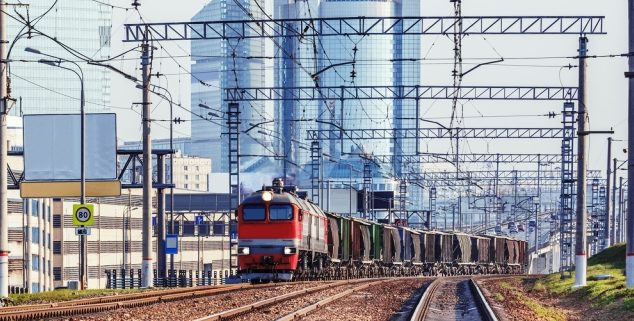Opinion
California’s road to sustainable freight
 A freight-laden train makes its way through a city's core. (Photo: Serjio74,. via Shutterstock)
A freight-laden train makes its way through a city's core. (Photo: Serjio74,. via Shutterstock)When most of us receive a package at our door from Amazon or another delivery service, we rarely think about the complex system that brought it to us, from manufacturing and packaging to shipping, sorting and last-mile delivery. But California’s massive freight system is key to both our economy and our environmental health.
The state’s network of highways and railways (thousands of miles’ worth), seaports (including the two largest in the country), airports, distribution centers, and border crossings supports a freight system that is responsible for one in three California jobs—and much of our air pollution. Any solution to California’s environmental health and climate change challenges must include more sustainable freight.
Freight is responsible for nearly half of all statewide emissions of diesel particulate matter and smog-forming nitrous oxide, two of the most health-harmful air pollutants.
Freight is an essential driver of the state, national and international economies. California receives the bulk of goods imported from Asia to the United States, and supplies more food to the rest of the country than any other state. Over five million Californians are employed in freight-related industries such as trade, manufacturing and transportation and warehousing, including hundreds of thousands of jobs generated directly or indirectly by the San Pedro Bay and Oakland ports.
But this expansive system comes at a significant environmental cost.
Freight is responsible for nearly half of all statewide emissions of diesel particulate matter and smog-forming nitrous oxide, two of the most health-harmful air pollutants. These emissions are associated with hundreds of deaths and hospitalizations each year, at billions of dollars in cost—effects felt most severely in the primarily low-income communities of color that neighbor our ports, highways, and other freight hubs.
Freight operations also contribute approximately six percent of California’s climate-warming greenhouse gas emissions. By law, the state must reduce total emissions 40 percent below 1990 levels by 2030.
The state government has begun to address the concerns of community and environmental advocates alike with a series of initiatives such as the Sustainable Freight Action Plan, which seeks to reduce the harmful impacts of freight while also supporting a system that is anticipated to more than double in total volume transported by 2040. At the same time, companies like Tesla and ProTerra are developing technologies like electric heavy-duty trucks that have the potential to revolutionize freight efficiency, although they require supportive infrastructure.
But these initiatives aren’t enough on their own. Moving the freight system toward economic and environmental sustainability will also require California to embrace greater coordination among policy, technology, infrastructure and more. Specifically, state and industry leaders should collaborate on measures related to funding, information sharing and workforce development, such as:
–Funding for new infrastructure, such as electric vehicle charging stations and freight-dedicated highway lanes, which can facilitate deployment of efficient technologies like heavy-duty truck electrification and truck “platooning”;
–Public-private information sharing platforms that encourage member organizations to share and analyze efficiency-related data while protecting valuable IP; and
–Expansion of workforce development initiatives, and high school and college supply chain management and logistics programs, to ensure that new freight projects will boost local economies.
Ultimately, the complexity and scale of California’s freight system means that no single entity has the power to drive these changes alone. However, leaders at state agencies such as the Air Resources Board, the Energy Commission, Caltrans and others can collaborate to provide adequate funding and outreach to industry, local communities and labor groups. Through their combined efforts, they can ensure that California’s future freight system is sustainable and generates the job growth, consumer benefits and health protections needed for a twenty-first century economy.
—
Ed’s Note: Ted Lamm is research fellow in the climate program at UC Berkeley Law’s Center for Law, Energy & the Environment (CLEE). He is co-author of the new report “Delivering the Goods: How California Can Create the Sustainable Freight System of the Future.”
Want to see more stories like this? Sign up for The Roundup, the free daily newsletter about California politics from the editors of Capitol Weekly. Stay up to date on the news you need to know.
Sign up below, then look for a confirmation email in your inbox.

Leave a Reply